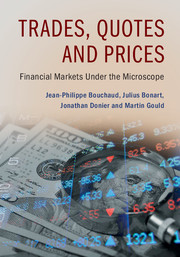Book contents
- Frontmatter
- Dedication
- Contents
- Preface
- Acknowledgements
- PART I HOW AND WHY DO PRICES MOVE?
- PART II LIMIT ORDER BOOKS: INTRODUCTION
- PART III LIMIT ORDER BOOKS: MODELS
- PART IV CLUSTERING AND CORRELATIONS
- PART V PRICE IMPACT
- PART VI MARKET DYNAMICS AT THE MICRO-SCALE
- PART VII ADVERSE SELECTION AND LIQUIDITY PROVISION
- PART VIII MARKET DYNAMICS AT THE MESO-SCALE
- PART IX PRACTICAL CONSEQUENCES
- Appendix
- Index
PART III - LIMIT ORDER BOOKS: MODELS
Published online by Cambridge University Press: 26 February 2018
- Frontmatter
- Dedication
- Contents
- Preface
- Acknowledgements
- PART I HOW AND WHY DO PRICES MOVE?
- PART II LIMIT ORDER BOOKS: INTRODUCTION
- PART III LIMIT ORDER BOOKS: MODELS
- PART IV CLUSTERING AND CORRELATIONS
- PART V PRICE IMPACT
- PART VI MARKET DYNAMICS AT THE MICRO-SCALE
- PART VII ADVERSE SELECTION AND LIQUIDITY PROVISION
- PART VIII MARKET DYNAMICS AT THE MESO-SCALE
- PART IX PRACTICAL CONSEQUENCES
- Appendix
- Index
Summary
Introduction
In this part, we will start our deep-dive into the mechanisms of price formation at the most microscopic scale. In the coming chapters, we will zoom in – in both space and time – to consider how the interactions between single orders contribute to the price-formation process in an LOB.
In line with our overall effort to start with elementary models before adding any layers of complexity, we will initially focus on purely stochastic, rather than strategic, behaviours. In short, we will assume that agents’ actions are governed by simple rules that can be summarised by stochastic processes with rate parameters that depend only on the current state of the world – or, more precisely, on the current state of the LOB.
We will start with the study of the volume dynamics of a single queue of orders at a given price. Such a queue grows due to the arrival of new limit orders, or shrinks due to limit orders being cancelled or executed against incoming market orders. We will investigate the behaviour of the average volume of a queue, its stationary distribution and its time to depletion when starting from a given size. We will repeat each of these analyses with different assumptions regarding the behaviour of the order flows, to illustrate how these quantities depend on the specific details of the modelling framework.
From there, extending the model to account for the joint behaviour of the bid and ask queues will be a natural next step. We will introduce the “race to the bottom” between the best bid and ask queues. This race dictates whether the next price move will be upwards (if the ask depletes first) or downwards (if the bid depletes first). We will then fit these order flows directly to empirical data, in a model-free attempt to analyse the interactions between order flow and LOB state.
We will end this modelling effort by introducing a stochastic model for the whole LOB. This approach, which is often called the Santa Fe model, will allow us to make some predictions concerning the LOB behaviour within and beyond the bid–ask spread. Comparison with real-world data will evidence that such a “zero-intelligence” approach of a purely stochastic order flow succeeds at explaining some market variables, but fails at capturing others.
- Type
- Chapter
- Information
- Trades, Quotes and PricesFinancial Markets Under the Microscope, pp. 75 - 77Publisher: Cambridge University PressPrint publication year: 2018

